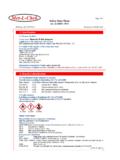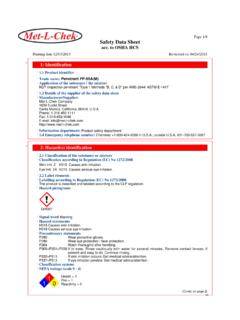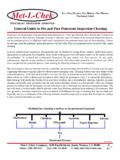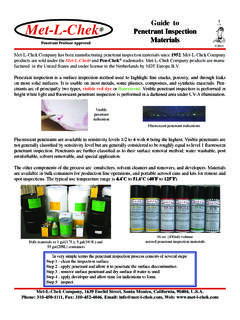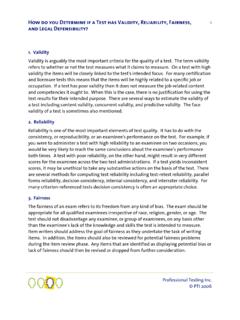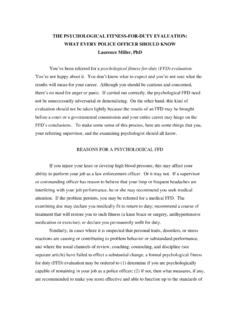Transcription of GENERAL GUIDE to TAM or STAR BURST TEST PANELS
1 Met-L-Chek . For Over 50 years; One History, One Mission, Maximum Value! PENETRANT PROFESSOR APPROVED. GENERAL GUIDE to TAM or STAR BURST TEST PANELS . The TAM or Star BURST test panel is easily one of the most misunderstood pieces of equipment in penetrant inspection. On the one hand, it is an invaluable device which, when properly used, allows one to monitor the performance of a penetrant inspection line. However, many panel users believe that these PANELS can do more than they are intended for, and this misunderstanding can cause problems. The Tam PANELS are made to a Pratt & Whitney drawing #146040, the originators of the panel, and were intended for use as a penetrant line processing monitor. The objective of the panel was to meet the requirements of ASTM E-1417-05 as a" known defect standard" and be used in the "System Performance" check to verify consistency of performance or a change in acomparative "sensitivity" It is the wording in the specification referring to the test as a sensitivity test which is the basis for so much confusion by users and auditors.
2 Note #2. of states that this test is not used to determine absolute sensitivity of the penetrant nor is the panel usable for this purpose. READ THE INSTRUCTIONS. There are a number of good reasons to read and understand the instructions. For example, a TAM panel is to be dedicated to a single penetrant line, and that line is to have only one kind of penetrant in it. A new panel is processed through the line, and the number of indications is recorded. This calibrates the panel, and establishes the number of indications which should be expected each time that particular panel is processed through the same penetrant line. If the panel initially shows three indications, and one day it only shows two indications, it is a sign that there might be a problem in the line, either with the materials, with the processing parameters, or the test panel itself.
3 ALL PANELS ARE NOT EQUAL. Suppose that you have a panel which shows three indications on a certain penetrant line. If you buy another panel and process it through the same line," how many indications should you expect to find?" Many would say three , but that is not necessarily true. It could be two, or three, or four, or even five. No two PANELS are the same. This is the reason why a single panel must be dedicated to a single penetrant line, and calibrated to that line. Suppose that you are using a panel which always shows four indications, and you decide to also use a second panel which shows three indications. The penetrant line is performing properly if the first panel shows four indications and the second shows three. The manufacturing drawing calls for the star BURST indications to be within a specified size range.
4 E. A " ( ) D. B " ( ) C. C " ( ). B. D " ( ). A. E " ( ). This means it is possible to have a panel with all high end or low end limit indications which would give different results through the same system. A panel with high end C, D, & E indications and low end A & B would also yield different results than one with star bursts of the reverse relationship. This and other reasons are why the PANELS are not sensitivity PANELS and this is clearly stated in the instructions from each of the manufacturers and by the originators, Pratt & Whitney. It is a process monitoring device which is to be dedicated to one process line to monitor consistency of the process. This fact has been overlooked by even seemingly knowledgeable NDT engineers, auditors, and level 3's who think they can assign a value of sensitivity by the number of stars that appear on a panel.
5 They are mistaken! genguide 1/2/06. Met-L-Chek Company, 1639 Euclid Street, Santa Monica, CA 90404 2006. Phone: (310) 450-1111 Fax: (310) 452-4046 E-Mail: Met-L-Chek . For Over 50 years; One History, One Mission, Maximum Value! PENETRANT PROFESSOR APPROVED. TAM or STAR BURST TEST PANELS . HOW TO MEASURE SENSITIVITY. The only widely approved and accepted method of measuring sensitivity is outlined in AMS-2644. One must use approved eletro optical measuring equipment, and a set of special Titanium and High Nickel alloy PANELS which contain calibrated cracks of various sizes. While anyone with the desire and the money to set up this type of equipment can do it, the catch is that there is only one set of approved cracked PANELS in existence.
6 These are at the Air Force Materials Laboratory at Wright-Patterson Air Force Base, Ohio. No one else is either authorized to make sensitivity evaluations, or has the proper cracked PANELS to use. All penetrants which have been approved under AMS-2644 to a certain sensitivity level have passed the Air Force test. Most major OEM's have accepted the criteria established in AMS -2644 as the sensitivity standard rating of penetrant materials. An individual with a TAM panel attempting to replicate these tests will not do so. Use the QPL to select approved materials. Use the Star BURST panel to monitor a single process line for consistency. CLEANING AFFECTS PANELS . One of the biggest problems with the PANELS , which can influence their validity as a process monitoring device is the ability to properly clean the panel; run after run.
7 To ensure that test results are proper and not influenced by residual material from a previous run thorough panel cleaning is required. One of the key issues is not so much whether residual penetrant caused the indications to show up, but rather "did residual developer prevent penetrant from entering the tighter cracks resulting in fewer than normal indications?" It is not uncommon for an auditor to spray nonaqeous developer on a panel to see if there is residual bleed out indicating all penetrant material has not been removed. Although this shows the residual penetrant, it might also be the start of another problem, that of possibly grinding developer into the crack if the developer is wiped from the surface. Cleaning PANELS is a multiple step process.
8 CLEANING STEPS FOR PANELS . 1. Water spray will generally wash developer residue from the surface of the panel. 2. Focused solvent spray such as R-503 (PMC# 9094) or R-504 (PMC# 9008) will wash penetrant from the tight defects. 3. Ultrasonically clean the panel in aqueous alkaline cleaner 300LF or # 210 for 10-20 minutes. 4. Rinse panel with clean water and then spray indications with R-503 or R-504 solvent. 5. Ultrasonically clean again for 5-10 minutes. Rinse with clean water and spray panel again with R-503 or R-504. 6. Store panel in solvent such as R-503, in a closed safety container away from open flames and sparks. 7. When the panel is to be used, spray the panel with R-503 or R-504 and allow it to dry or place it in the drier.
9 If warm air dried, do not process panel till it has reached ambient temperature. Note: solvents are flammable and should be used in a flame free environment. Follow label precautions. PANEL RESULTS. Always record the number and GENERAL appearance of the indications and the rough surface background. Some users have taken photographs of the PANELS to try to create a permanent record, but inconsistency in the photographic process can in itself create discrepancies. Fixed indication transfers are also used but penetrant migration over time will require periodic replacement of the transfers. A sudden change in panel appearance will require thorough panel cleaning and rerunning the panel to verify that the change was not simply an anomaly or caused by poor panel cleaning.
10 If the deviation repeats, the processing steps must be reviewed for cause of the change. Areas to check are the drier temperature, water pressure, wash and emulsifier contact times, developer application, and any new personnel. A review of the material checks (specified in ASTM E-1417) should also be done to verify that the materials have all been within specified limits. Remember the panel is a process control monitoring device, not a sensitivity measurement. genguide 2/2/06. Met-L-Chek Company, 1639 Euclid Street, Santa Monica, CA 90404 2006. Phone: (310) 450-1111 Fax: (310) 452-4046 E-Mail.
